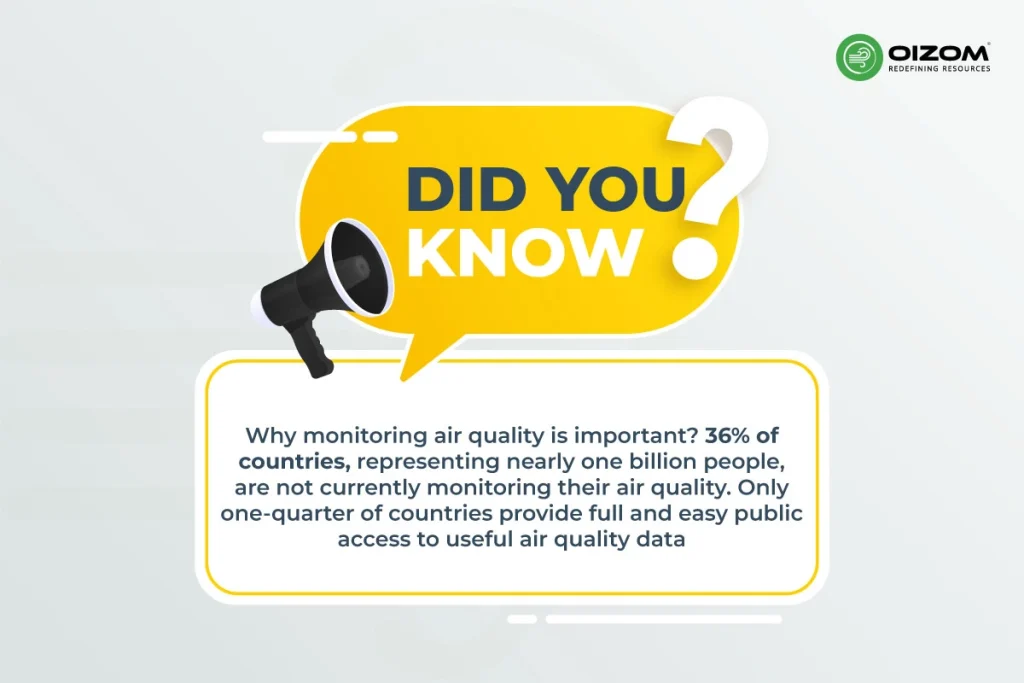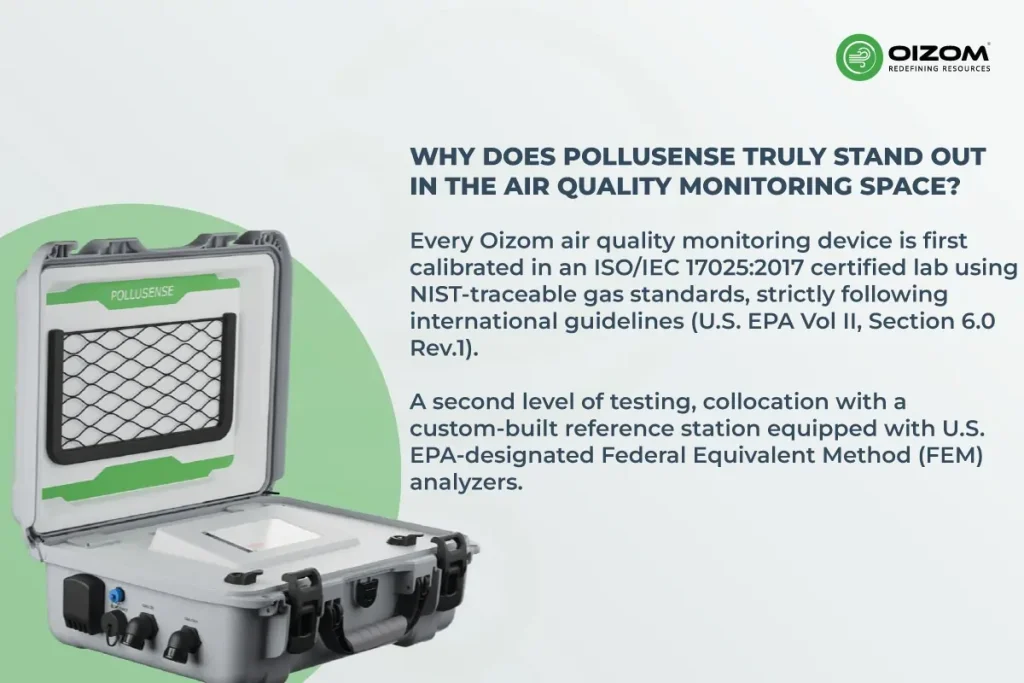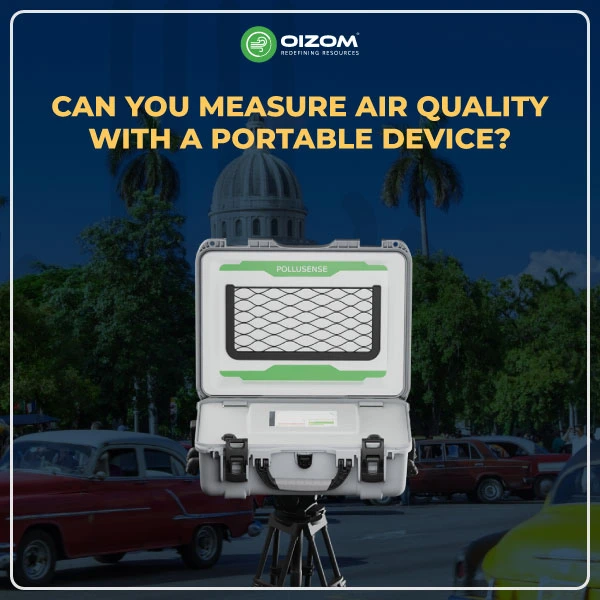10 Key Takeaway Points
- Easy to Carry, Highly Accurate: Portable air quality monitors are small but powerful, giving lab-like results on the go.
- Smart Sensors Inside: They use advanced sensors to measure dust (PM1, PM2.5, PM10) and harmful gases like CO, NO₂, SO₂, O₃, VOCs, and formaldehyde.
- Instant Air Quality Data: These devices show real-time readings so you can take quick action when needed.
- Stay Connected Anywhere: With GPS, Wi-Fi, or LTE, data can be sent to the cloud for remote access and live tracking.
- No Internet? No Problem: Devices like Pollusense have large storage (16GB), saving up to 90 days of data offline.
- Long Battery Support: Built-in batteries let you monitor air quality for long hours without needing to recharge often.
- Built Tough for Any Location: Portable monitors can handle rough environments, from factories to remote sites.
- Simple to Use: They come ready with a screen, easy setup, and changeable sensors.
- Accurate and Reliable: Regular calibration ensures the data stays trustworthy, even in different weather conditions.
- Helpful for Real Decisions: These tools help experts quickly check air quality, do audits, and protect public health.
Can You Measure Air Quality with a Portable Device?
Air quality monitoring is no longer limited to fixed, bulky setups. With rapid advancements in sensor miniaturization and IoT integration, professionals can now carry lab-like precision in a compact, rugged device, ready to deploy anywhere, anytime.
Modern portable air quality monitors are built for the field. In advanced models, these devices can measure a wide range of pollutants, including PM1, PM2.5, PM10, CO, NO₂, SO₂, O₃, VOCs, and even formaldehyde or BTEX. Many come with built-in GPS, long battery life, real-time data streaming, and onboard memory, making them ideal for short-term assessments, hotspot identification, emergency response, and regulatory audits.
Technically speaking, today’s portable monitors feature electrochemical, NDIR, PID, and laser-scattering sensors with smart algorithms for data correction and environmental compensation. Some even offer modular sensor slots, allowing you to switch or upgrade based on your project needs.
Whether you’re validating data from a Continuous Ambient Air Quality Monitoring System (CAAQMS), conducting environmental impact assessments, or monitoring worker exposure in industrial zones, portable monitors deliver accurate insights without the logistical hassles of fixed stations.
In this blog, we’ll explore the core technologies powering portable air quality monitors, discuss the types of pollutants they detect, and break down how they’re helping experts like you make faster, smarter, and more localized decisions in the fight for cleaner air.
How Portable Air Quality Devices Measure Air Quality?

Portable air quality monitors work by detecting and measuring pollutants in the air around them. They’re equipped with various sensors that track specific pollutants like particulate matter (PM), gases (such as CO2, NO2, ozone, and other relevant gases), and even environmental factors like temperature and humidity. These sensors gather data in real time, providing a clear snapshot of the air quality at any given moment.
The device typically uses laser-based or electrochemical sensors to capture the concentration of different pollutants. For example, laser sensors are commonly used to detect particulate matter by measuring how light scatters when it hits particles in the air. Electrochemical sensors, on the other hand, measure gases by reacting chemically with the pollutants to produce an electrical signal.
What makes portable monitors stand out is their ability to collect data on the go. Unlike fixed monitors, they can be used anywhere from industrial sites to neighborhoods, providing more flexible and immediate air quality assessments. The data doesn’t just sit in the device. With onboard microcontrollers and IoT modules, measurements can be stored locally and transmitted in real-time via Wi-Fi, LTE, or LoRa. Advanced models offer GPS tagging and cloud-based dashboards for remote access, trend analysis, and report generation.
What sets these devices apart is their ability to maintain accuracy while staying mobile. With built-in calibration protocols, zero-drift handling, and modular sensor designs, portable monitors ensure the data you collect in the field is both reliable and actionable. In short, they bring lab-grade monitoring to your fingertips, minus the complexity.
Top Portable Air Quality Devices in the Market
With rising demand for on-the-go air quality assessments, the market has responded with a range of high-performance portable monitors, each offering a unique blend of precision, durability, and connectivity. However, not all devices are built the same. For professionals in the field, choosing the right monitor means looking beyond just PM readings.
But for professionals who need reliable, real-time insights in dynamic environments, the technical specs matter. Advanced portable monitors now combine electrochemical, NDIR, PID, and laser-based sensors to measure a broad spectrum of pollutants, PM1, PM2.5, PM10, CO, NO₂, SO₂, O₃, VOCs, and even parameters like noise and temperature. Features like cloud connectivity, GPS tagging, built-in data logging, and long battery life have become essential for field deployments.
While several brands offer impressive solutions, this section will focus on Oizom’s Pollusense, a powerful, field-ready portable air quality monitor designed for professionals. With the ability to measure up to 30+ environmental parameters, a rugged suitcase or compact form factor, and seamless data integration capabilities, Pollusense stands out for its versatility and accuracy across diverse applications, from industrial audits to environmental field studies.
Let’s take a closer look at what sets Pollusense apart in the increasingly competitive market of portable air quality devices.
Pollusense: The Portable Air Quality Monitoring Solution
Pollusense is a Portable Air Quality Monitoring System that measures multiple toxic gases and particulate matter along with noise. The device offers a range of customizable parameters, making it ideal for various applications such as environmental impact assessments, industrial monitoring, environmental audits, mining, indoor air quality assessment, leak detection, construction sites, landfills, livestock management, and research.
Pollusense is a compact and briefcase-sized device that can be carried anywhere to get accurate air quality data. It also has an on-device display that lets users check parameters directly. The data collected by Pollusense can also be accessed through Oizom’s EnvizomTM environmental monitoring software, enabling comprehensive data visualization and analytics.
Here’s a sneak peek at this portable air quality monitoring – Pollusense, don’t miss it!”
Features of Pollusense:
When choosing air quality monitors, a variety of factors should be considered. Furthermore, OIZOM’s strategy for reaching those aims can be summarized in a variety of topics;
- Installation and Operational Ease: Pollusense is Oizom’s innovative portable air quality monitoring device, designed for flexibility and ease of use. Its compact, plug-and-play system makes installation easy; just set it up and start monitoring immediately. Plus, with its long-lasting battery, you can rely on Pollusense for extended periods without constant recharging, making it perfect for on-the-go monitoring.
- Reliability is at the core of Pollusense. It delivers highly accurate data through Oizom’s advanced calibration methods, ensuring that you can trust the results. This includes factory calibration for basic functionality, lab calibration for precise data accuracy, and on-site collocation calibration against a reference station. Pollusense provides more accurate measurements compared to traditional methods.
- Accessibility is another key feature. With real-time data, smart device compatibility, and an in-built display, you can easily monitor air quality from anywhere, making it convenient for quick, on-site data analysis. This makes Pollusense an excellent choice for environmental audits, compliance checks, or quick spot assessments, as you have instant access to detailed air quality information right at your fingertips.
- Flexibility: What sets Pollusense apart is its flexibility. Unlike stationary monitors, which are fixed in one location, Pollusense allows you to measure air quality across different sites. Whether you’re in the field or moving between locations, Pollusense adapts to your needs, giving you reliable insights wherever you go.

Limitations of Portable Air Quality Devices
While portable air quality monitors offer flexibility and convenience, they do come with certain limitations. One key challenge is sensor accuracy in extreme environments. Factors like high humidity, temperature changes, or dust can affect sensor performance, requiring regular calibration to ensure reliable data.
Battery life can also be a limitation. Although these devices are equipped with rechargeable batteries, they may need frequent recharging during long-term monitoring, especially in remote locations without access to power sources.
Data storage can pose a challenge for some portable air quality monitors, as limited onboard storage often requires frequent data transfers or consistent internet access for cloud-based storage. However, with Pollusense, users don’t need to worry. It comes equipped with 16GB of internal storage, allowing for 90 days of continuous data logging, ensuring reliable data capture without the need for constant transfers or connectivity.
Conclusion
Remember when tracking air quality felt like rocket science? Gone are the days when you had to wait for lab reports to understand your environment. We’ve come a long way. Today, portable air quality monitors are changing how we see the air around us, making complex environmental data as easy to access as checking your phone.
The Tech Revolution, Right in Your Hand: Imagine carrying a smart little device that acts like your personal air quality detective. These aren’t just cool gadgets anymore; they’re reliable tools that help you understand what you’re breathing.
We’re talking about:
- Sensors that detect pollutants smaller than a strand of hair.
- Real-time data that reveals what your eyes can’t.
- The tech that turns complicated air science into simple, useful insights.
What’s Coming Next? The future of air quality monitoring is exciting. Soon, we’ll see:
- AI-driven predictions that can alert you before pollution spikes.
- Hyperlocal tracking, down to your street or even your room.
- Wearable monitors that fit into your daily routine.
- Global citizen networks collect powerful environmental data.
More Than Just Numbers, A Healthier Tomorrow
These devices do more than just measure air; they empower us to act. Every data point helps us build cleaner cities, improve planning, and protect public health. In the next few years, portable air quality monitoring will go from a specialty tool to something we all rely on, reshaping how we connect with the air around us. Stay curious, stay aware, and breathe better.






